-
 Bitcoin
Bitcoin $84,406.3890
3.25% -
 Ethereum
Ethereum $1,880.4779
5.04% -
 Tether USDt
Tether USDt $1.0001
0.03% -
 XRP
XRP $2.1723
6.11% -
 BNB
BNB $615.3056
4.09% -
 Solana
Solana $128.7903
4.18% -
 USDC
USDC $1.0002
0.03% -
 Dogecoin
Dogecoin $0.1728
6.80% -
 Cardano
Cardano $0.6806
6.97% -
 TRON
TRON $0.2338
0.47% -
 Toncoin
Toncoin $4.1204
6.33% -
 Chainlink
Chainlink $14.0113
7.28% -
 UNUS SED LEO
UNUS SED LEO $9.2104
1.23% -
 Stellar
Stellar $0.2738
4.67% -
 Avalanche
Avalanche $19.6047
6.85% -
 Sui
Sui $2.4325
10.07% -
 Shiba Inu
Shiba Inu $0.0...01286
6.52% -
 Hedera
Hedera $0.1713
8.46% -
 Polkadot
Polkadot $4.2367
6.37% -
 Litecoin
Litecoin $84.9399
4.41% -
 Bitcoin Cash
Bitcoin Cash $313.0576
6.35% -
 MANTRA
MANTRA $6.2849
1.80% -
 Bitget Token
Bitget Token $4.6422
5.31% -
 Dai
Dai $1.0000
0.02% -
 Ethena USDe
Ethena USDe $0.9997
-0.02% -
 Pi
Pi $0.7157
4.31% -
 Hyperliquid
Hyperliquid $13.8582
9.07% -
 Monero
Monero $217.1999
1.03% -
 Uniswap
Uniswap $6.1894
6.93% -
 Aptos
Aptos $5.3745
5.09%
How do blockchain browsers track asset flows?
Blockchain browsers offer transparent views of asset flows on blockchain networks, but they don't track personal identities, only pseudonymous addresses.
Mar 30, 2025 at 02:35 pm
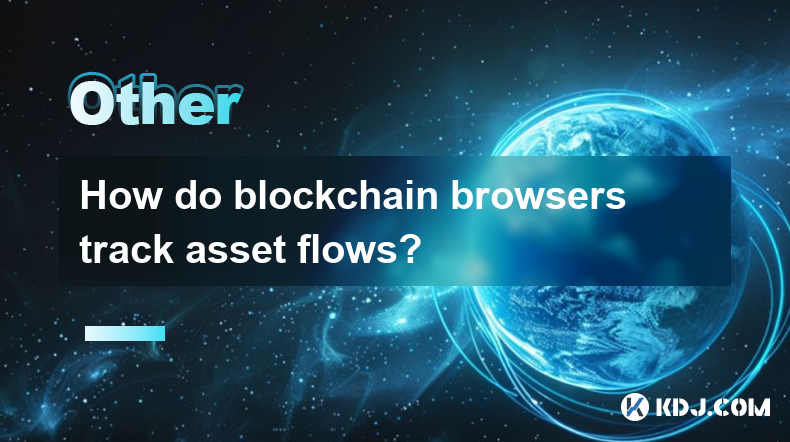
Understanding Blockchain Exploration and Asset Tracking
Blockchain browsers, unlike traditional web browsers, are specialized tools designed to explore and analyze data on a blockchain network. They don't "track" assets in the sense of following individual users. Instead, they provide a transparent view of on-chain transactions, allowing users to observe the movement of assets across the network. This transparency is a core feature of blockchain technology, ensuring that all transactions are publicly verifiable.
This transparency is achieved through the immutability of the blockchain. Once a transaction is recorded, it cannot be altered or deleted. This means that the flow of assets, represented by transaction records, is permanently etched onto the blockchain. Blockchain browsers simply provide the tools to access and interpret this information. They don't actively monitor or follow specific assets; they simply present the data as it exists on the blockchain.
The Mechanics of Tracking Asset Flows
Blockchain browsers utilize various methods to visualize and analyze asset flows. The primary method involves analyzing transaction data. Each transaction on a blockchain contains crucial information, including the sender's address, the recipient's address, and the amount of cryptocurrency transferred. Blockchain browsers aggregate this data to display the movement of assets over time.
- They access the blockchain's raw data directly.
- They parse and interpret the transaction data.
- They use algorithms to link transactions based on addresses.
- They create visual representations of asset flows, often using graphs or charts.
This process allows users to trace the path of specific assets across the network, identifying intermediary addresses and observing the overall flow of funds. The level of detail and sophistication varies depending on the specific blockchain browser being used.
Data Visualization and Analysis Tools
Many blockchain browsers offer sophisticated data visualization tools. These tools help users make sense of the vast amount of transaction data available. Common visualization techniques include:
- Transaction graphs: These graphs visually represent the flow of assets between different addresses. Nodes represent addresses, and edges represent transactions.
- Charts and tables: These provide a summarized view of transaction data, allowing users to analyze trends and patterns over time.
- Address tagging: Some browsers allow users to tag addresses with labels, making it easier to track specific entities or organizations.
- Filtering and searching: These functions allow users to focus on specific transactions or addresses, reducing the complexity of the data.
These tools are crucial for analyzing large datasets and identifying patterns that might be otherwise difficult to discern.
Privacy Considerations and Pseudonymity
While blockchain browsers offer transparent views of asset flows, it's important to understand the limitations concerning privacy. While transactions are public, addresses are typically pseudonymous. This means that they don't directly reveal the identity of the users involved. However, it is possible to link addresses to real-world identities through various methods, although this often requires significant investigative work.
Therefore, while blockchain browsers show the flow of assets, they don't automatically reveal the identities of the individuals or entities behind those addresses. The level of privacy depends on how carefully users protect their identity and the sophistication of any analysis performed on the blockchain data.
Different Blockchain Browsers and their Capabilities
Various blockchain browsers exist, each with its own strengths and weaknesses. Some specialize in specific blockchains, while others offer support for multiple networks. The features and capabilities also vary significantly. Some browsers offer basic transaction exploration, while others provide advanced analytics and visualization tools.
Choosing the right blockchain browser depends on the specific needs of the user. Factors to consider include the blockchains supported, the available analytics tools, the user interface, and the level of detail provided.
Exploring Specific Transaction Details
Blockchain browsers allow users to delve into the specifics of individual transactions. By clicking on a transaction in the browser, users can access detailed information, including:
- The exact amount of cryptocurrency transferred.
- The timestamp of the transaction.
- The fees paid for the transaction.
- The gas used (for Ethereum and similar blockchains).
- The transaction hash (a unique identifier for the transaction).
This level of detail is essential for verifying the authenticity of transactions and understanding the context of asset movements.
Limitations of Blockchain Browsers
While powerful tools, blockchain browsers have limitations. They only show on-chain activity. Off-chain transactions, which occur outside the public blockchain, are not visible. Furthermore, interpreting complex transaction patterns can be challenging, particularly for users without technical expertise. The sheer volume of data can also be overwhelming.
It's crucial to understand that blockchain browsers provide a snapshot of on-chain activity and not a complete picture of all financial movements.
The Role of Blockchain Explorers in Security Audits
Blockchain explorers play a vital role in security audits. By analyzing transaction data, security professionals can identify potential vulnerabilities and fraudulent activities. They can track the movement of funds to identify suspicious patterns and investigate potential hacks or thefts. This is a critical aspect of maintaining the security and integrity of blockchain networks.
Future Developments in Blockchain Browsers
The field of blockchain exploration is constantly evolving. Future developments are likely to focus on improving user experience, enhancing data visualization techniques, and integrating more advanced analytics tools. The goal is to make blockchain data more accessible and easier to interpret for a wider range of users.
Frequently Asked Questions
Q: Can blockchain browsers track my personal identity?
A: No, blockchain browsers primarily track transactions using pseudonymous addresses. While linking addresses to real-world identities is possible, it's not inherent to the functionality of blockchain browsers and often requires significant investigative effort.
Q: Are all blockchain browsers the same?
A: No, different blockchain browsers offer varying levels of functionality, support for different blockchains, and different user interfaces. Choosing the right browser depends on your specific needs.
Q: Can blockchain browsers track all financial transactions?
A: No, blockchain browsers only track transactions recorded on the blockchain. Off-chain transactions are not visible.
Q: How accurate is the data presented by blockchain browsers?
A: The data presented is generally accurate, as it's directly derived from the blockchain. However, the interpretation of that data can be complex and requires careful consideration.
Q: Are blockchain browsers safe to use?
A: Reputable blockchain browsers from trusted sources are generally safe. However, it's always wise to exercise caution and only use browsers from verified sources to avoid potential malware or phishing scams.
Disclaimer:info@kdj.com
The information provided is not trading advice. kdj.com does not assume any responsibility for any investments made based on the information provided in this article. Cryptocurrencies are highly volatile and it is highly recommended that you invest with caution after thorough research!
If you believe that the content used on this website infringes your copyright, please contact us immediately (info@kdj.com) and we will delete it promptly.
- Circle Internet Financial, the Entity Behind the USD Coin (USDC) Stablecoin, Is Taking a Significant Step Towards Public Markets
- 2025-04-01 18:10:12
- The Pi Coin's price has been a subject to rapid fluctuations
- 2025-04-01 18:10:12
- Bitcoin Could Supplant the Dollar as the World's Benchmark
- 2025-04-01 18:05:12
- President Trump's Sons Don Jr. and Eric Trump Have Invested in a Bitcoin Mining Venture
- 2025-04-01 18:05:12
- Key Insights: A Reuters report notes that President Donald Trump's family in January gained control of World Liberty Financial (WLF), a crypto venture that raised over half a billion dollars.
- 2025-04-01 18:00:11
- Elon Musk Rules Out US Government's Use of Dogecoin (DOGE)
- 2025-04-01 18:00:11
Related knowledge
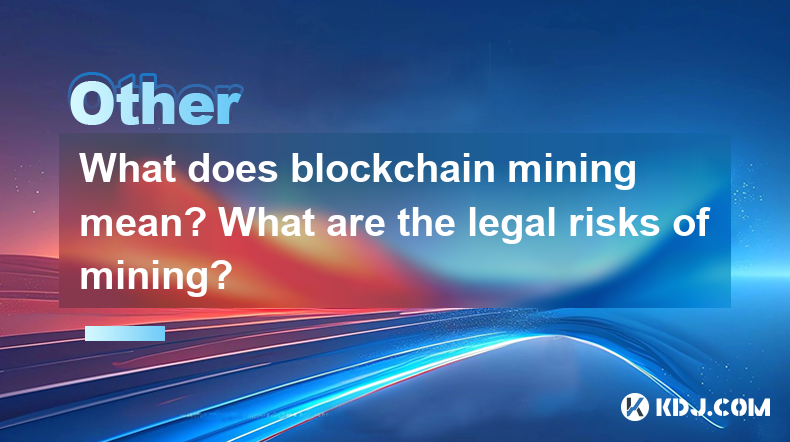
What does blockchain mining mean? What are the legal risks of mining?
Mar 31,2025 at 05:07pm
Blockchain mining is the process by which transactions are verified and added to the public ledger, known as the blockchain. Miners use powerful computers to solve complex mathematical problems, which, once solved, allow them to add a block of transactions to the blockchain. In return, miners are rewarded with cryptocurrency, typically Bitcoin. This pro...
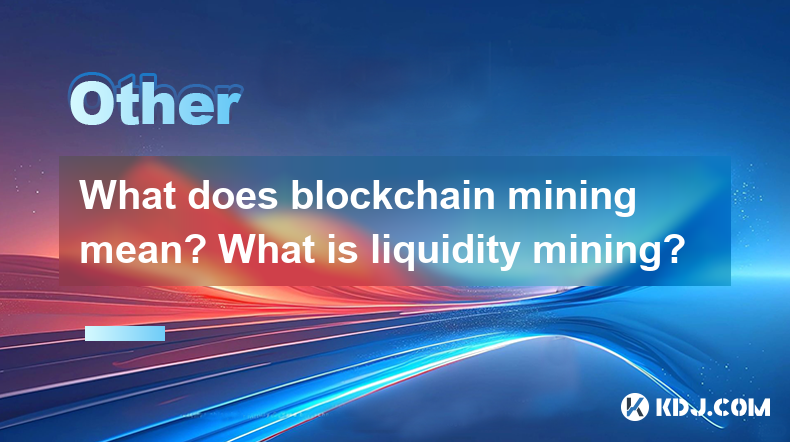
What does blockchain mining mean? What is liquidity mining?
Apr 01,2025 at 12:07am
What is Blockchain Mining?Blockchain mining is a critical process in the world of cryptocurrencies, particularly for networks like Bitcoin and Ethereum. It involves the use of computational power to solve complex mathematical problems, which in turn validates transactions and adds them to the blockchain. Miners are incentivized through rewards, typicall...
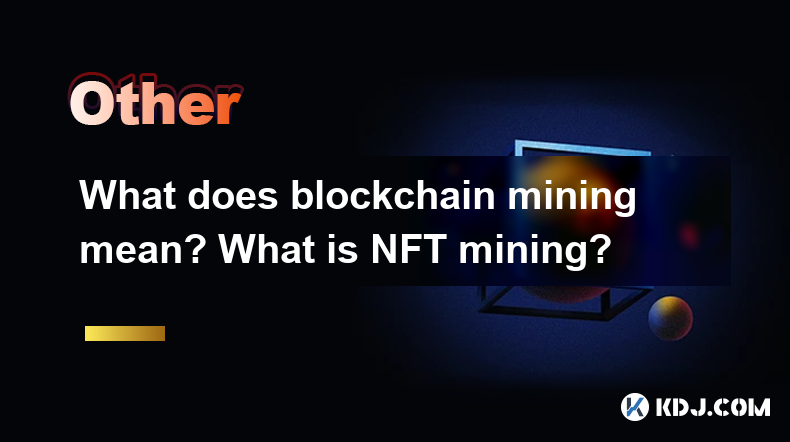
What does blockchain mining mean? What is NFT mining?
Mar 31,2025 at 04:07pm
Blockchain mining is a crucial process in the world of cryptocurrencies, particularly for networks like Bitcoin and Ethereum. It involves verifying transactions and adding them to the blockchain, a decentralized ledger. Miners use powerful computers to solve complex mathematical problems, which, when solved, allow them to add a block of transactions to ...

What does blockchain mining mean? What is the difference between cold wallets and hot wallets for mining?
Apr 01,2025 at 07:56am
Blockchain mining is a critical process in the world of cryptocurrencies. It involves verifying transactions and adding them to the blockchain, a decentralized ledger. Miners use powerful computers to solve complex mathematical problems, which, when solved, allow them to add a block of transactions to the blockchain. In return, miners are rewarded with ...
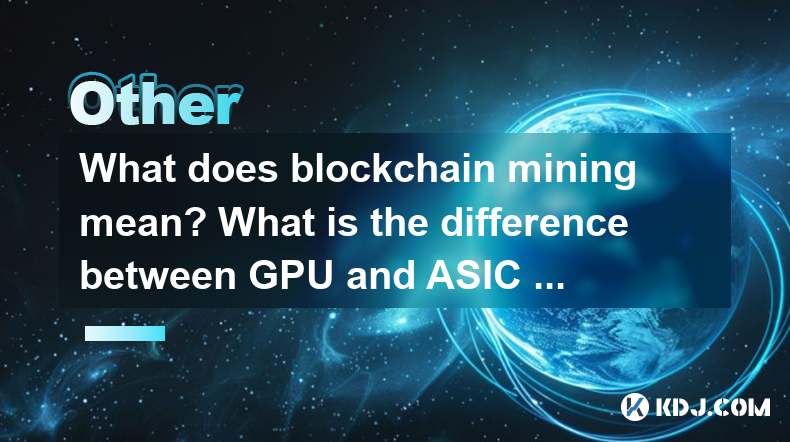
What does blockchain mining mean? What is the difference between GPU and ASIC mining?
Apr 01,2025 at 11:56am
Blockchain mining is a crucial process in the world of cryptocurrencies, particularly for networks like Bitcoin and Ethereum. At its core, mining involves solving complex mathematical problems to validate transactions and add them to the blockchain, a decentralized ledger. Miners compete to solve these problems, and the first to succeed is rewarded with...
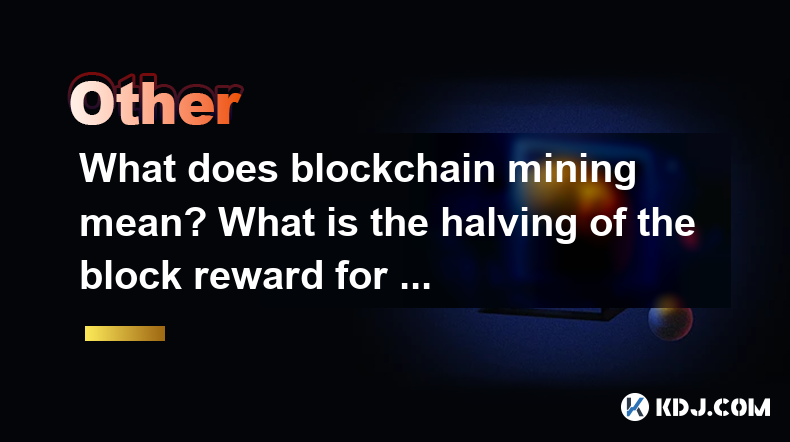
What does blockchain mining mean? What is the halving of the block reward for mining?
Mar 31,2025 at 03:43pm
Blockchain mining is a crucial process in the world of cryptocurrencies, particularly for networks like Bitcoin. It involves solving complex mathematical problems to validate transactions and add them to the blockchain, a public ledger of all cryptocurrency transactions. Miners use powerful computers to compete in solving these problems, and the first t...

What does blockchain mining mean? What are the legal risks of mining?
Mar 31,2025 at 05:07pm
Blockchain mining is the process by which transactions are verified and added to the public ledger, known as the blockchain. Miners use powerful computers to solve complex mathematical problems, which, once solved, allow them to add a block of transactions to the blockchain. In return, miners are rewarded with cryptocurrency, typically Bitcoin. This pro...

What does blockchain mining mean? What is liquidity mining?
Apr 01,2025 at 12:07am
What is Blockchain Mining?Blockchain mining is a critical process in the world of cryptocurrencies, particularly for networks like Bitcoin and Ethereum. It involves the use of computational power to solve complex mathematical problems, which in turn validates transactions and adds them to the blockchain. Miners are incentivized through rewards, typicall...

What does blockchain mining mean? What is NFT mining?
Mar 31,2025 at 04:07pm
Blockchain mining is a crucial process in the world of cryptocurrencies, particularly for networks like Bitcoin and Ethereum. It involves verifying transactions and adding them to the blockchain, a decentralized ledger. Miners use powerful computers to solve complex mathematical problems, which, when solved, allow them to add a block of transactions to ...

What does blockchain mining mean? What is the difference between cold wallets and hot wallets for mining?
Apr 01,2025 at 07:56am
Blockchain mining is a critical process in the world of cryptocurrencies. It involves verifying transactions and adding them to the blockchain, a decentralized ledger. Miners use powerful computers to solve complex mathematical problems, which, when solved, allow them to add a block of transactions to the blockchain. In return, miners are rewarded with ...

What does blockchain mining mean? What is the difference between GPU and ASIC mining?
Apr 01,2025 at 11:56am
Blockchain mining is a crucial process in the world of cryptocurrencies, particularly for networks like Bitcoin and Ethereum. At its core, mining involves solving complex mathematical problems to validate transactions and add them to the blockchain, a decentralized ledger. Miners compete to solve these problems, and the first to succeed is rewarded with...

What does blockchain mining mean? What is the halving of the block reward for mining?
Mar 31,2025 at 03:43pm
Blockchain mining is a crucial process in the world of cryptocurrencies, particularly for networks like Bitcoin. It involves solving complex mathematical problems to validate transactions and add them to the blockchain, a public ledger of all cryptocurrency transactions. Miners use powerful computers to compete in solving these problems, and the first t...
See all articles























































































